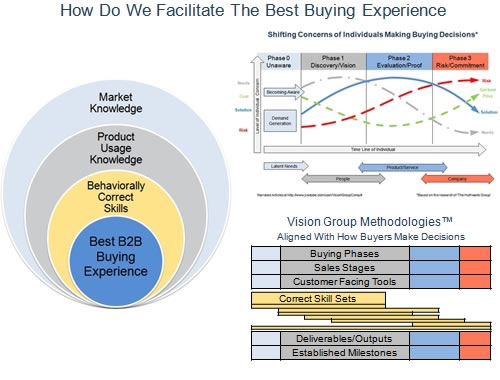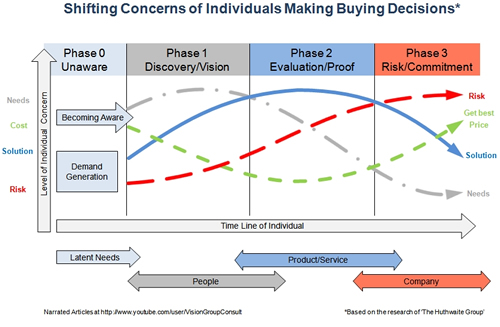To Create the Best Buying Experience in B2B, Begin With Behaviorally Correct Skills
When our sales and marketing methods are aligned with our customers buying process we begin to create The Best Buying Experience. Focusing on the buyers shifting concerns as they make buying decisions prepares us to use the proper skills at the right time.
To achieve the Best Buying Experience, B2B buyers expect sellers to have market knowledge, product usage knowledge, and behaviorally correct skills throughout a consultative buying process.
To enable the Best Buying Experience, our clients align their sales and marketing methods with how their customers make buying decisions for their products and services.
Aligning the buy sell cycle on discovering the buyer’s needs first and then helping the buyers understand how the products and services can help achieve their business needs.

Our job is to be buying facilitators, not just sales people.
Looking at the diagram below, there are 3 main phases as an individual is making a buying decision. In phase 0, the individual is unaware. As needs are discovered they move from the back of the mind to the front, (latent to active needs).
- In phase 1, the individual's main concern is to discover and define their needs. As the needs are defined, they begin looking for solutions.
- In phase 2, the individual is focused on evaluating potential solutions and looking for proof. Risk begins to rise as they move towards a buying decision.
- In phase 3, risk contines to rise as the buying decision moves closer and the individual is also looking for the best price.
The 4 primary concerns during the buy sell cycle are needs, solution, cost, and risk. (Cost becomes price towards the end, because who doesn't want the "best price".)
Hear more about the shifting concerns of buyers as they make buying decisions via a short video.

One of the first behaviorally correct skills is to focus on the buyers shifting concerns and where they are
in the buy-sell cycle as we help them discover solutions for their compelling business needs.
Individuals are focused on their needs and solutions in phase 1. They want to know if a buying facilitator, (sales person), can assist them in discoverying their needs and relevant solutions.
Thinking about it from a buyer’s point of view, discussing product details too early is out of alignment with their expectations. It is knowledge of the customer's market place and the applications they use which are most important to the individual at the beginning of the buy-sell cycle, not product knowledge.
A proper behavior while discovering needs is to explain your products and services in ways a prospective prospect can easily visualize the business usage. It is not about the product and service features in the discovery phase. The customer wants to know if you can help them achieve their needs, their main concern at this point in the buy sell cycle.
Prospects prefer to have business conversations around relevant usage in their market place during the discovery phase. Don't bore them to death with product pitches and power point presentations. They also expect sellers to understand the various types of standards imposed by regulatory or industry requirements the prospect needs to comply with in their market space.
Said another way, prospects are looking for sellers who have knowledge of how they have helped other customers in similiar positions.
The best sales people do this naturally; they use the power of story to explain how the products and services business “usage” will help the customer achieve their needs. Discussing their products and services wrapped in stories of how they have helped other customers in similiar markets and positions to the individual they are calling on.
The lost art of telling stories woven with how your products/services are "used" by your customers
is one of the most powerful ways to make a human connection with new or existing clients.
Demonstrating market and product “usage” knowledge as we use common words spoken by our customer’s marketplace, not our companies internal technical language.
To become proficient at consultative selling it is not enough to ask good questions and listen, we also need to stay aligned with our buyers shifting concerns as they are making buying decisions and demonstrating behaviorally correct skills though out the buy/sell cycle.
The Best Buying Experience is a series of articles being written by the Vision Group. Part 1 is about working with a buying committee during the discovery phase.
